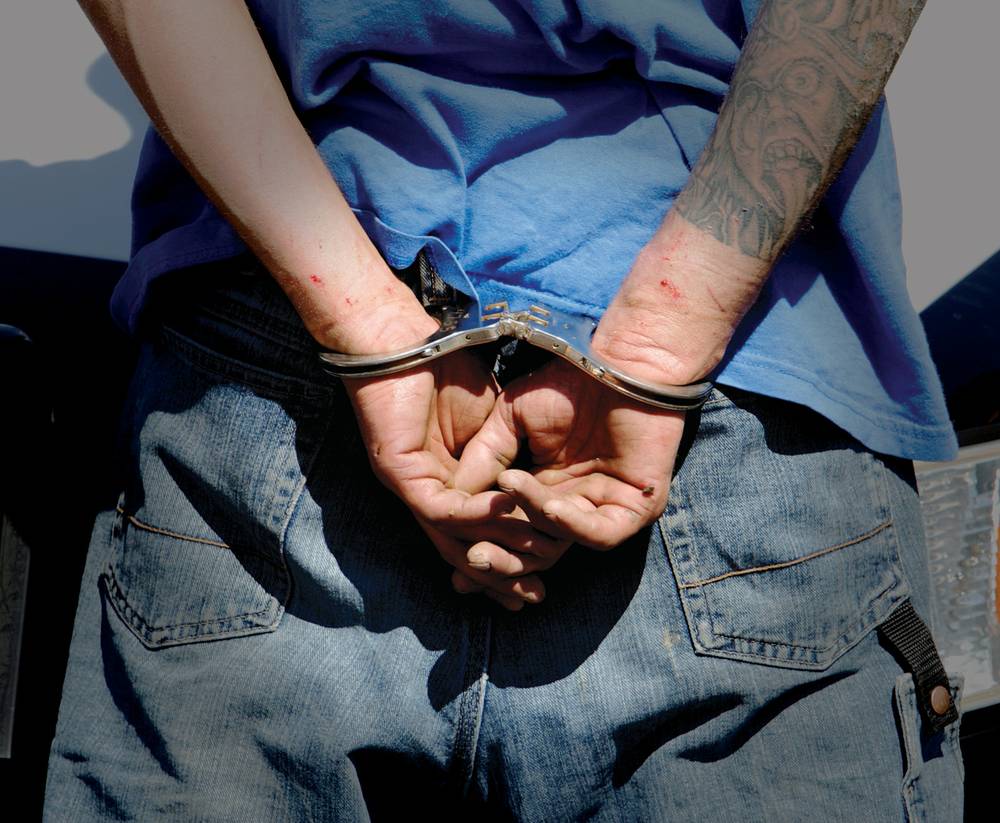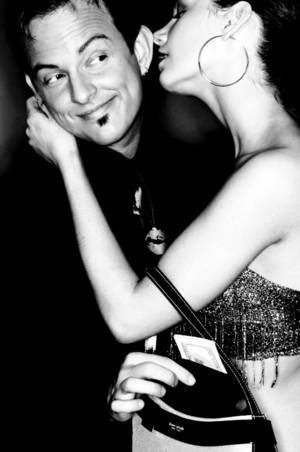“Hey, baby. You got a light?”
The jaundiced glow of Larry Flynt’s Hustler Club pooled in the woman’s eyes and the tinted windows of her Escalade, which pulled up next to Las Vegas Sun designer Dave Mondt out of nowhere. He was walking off an evening of cocktails on the way to his car—a two-mile trek down Dean Martin Drive in the hot dark.
More
- Related Stories
- True Crime: Tales straight from Las Vegas streets
- Beyond the Weekly
- istealstuff.com
- LVMPD Crime Map
“Sorry. I don’t smoke,” he said, but by the end of the sentence she was breathing in his ear, her flimsy leather dress looking ready to snap. She asked if he needed company, groping the sincerity of her offer. When he pushed her away, she said if he didn’t like black girls she had white friends in the backseat who wanted to party. “You don’t get it,” he said. “I don’t like girls.”
Watching her taillights fade, Mondt went for his BlackBerry so he could tell someone what happened. But it was no longer in his hand.
“It was old and had a crack in it, and the roller ball didn’t work. My first thought was that she might come back, run me over and take my wallet instead,” Mondt says, shaking his head. Even drunk, he knew better than to walk so far so late in Las Vegas, but something primal tells us to take dumb risks, that we will be the ones to get away with it. “I got off pretty cheap,” he says. “But I have to change the way I think about people.”
From Discman to DVR
It’s easy to say you should never trust a hooker on a lonely road, but crime isn’t limited to the usual suspects in the usual settings. Sometimes a hooker does just need a light, and the granny in distress could be baiting you into a choreographed mugging. Especially in Las Vegas, where the whole world comes to cut loose, it can be hard to separate the sheep from the wolves.
More
- Crime By Numbers
- 7: Consecutive years, counting back from 2010, Nevada was ranked the most dangerous state in the CQ Press State Crime Rankings, based on rates of assault, burglary, murder, motor vehicle theft, rape and robbery, concentrated in the population center of Las Vegas.
- 6: Percentage decrease in the overall crime index from 2009 to 2010 reported by the Las Vegas Metropolitan Police Department, part of a five-year trend.
- 29: Percentage of females arrested for motor vehicle theft in Nevada in 2008, 12 percent higher than the national average.
- 17: Las Vegas’ current national ranking for motor vehicle theft, down from the No. 1 city in 2006.
- 81: Total, in millions, of the monetary losses from burglaries in Nevada in 2007.
- 7,436: Juvenile arrests by Metro in 2010, compared to 101,473 adult arrests.
- 3: Number of times Apollo “The Gentleman Thief” Robbins has removed eye glasses from peoples’ faces without them knowing.
And there are a lot more wolves these days thanks to the Internet, wolves who don’t have to be particularly skillful or careful to score big. Black market websites that function like eBay invite people to bid on other people’s personal information like they would a pair of rollerblades or a litter of hamsters. Credit card skimmers are rampant, making a trip to the gas station a potential vector for financial ruin. But in this era of faceless insta-crime, what about the old-school thieves and their small-time hustles? Have they gone the way of the Discman and VCR they pilfered and pawned once upon a time?
The 43,219 property crimes reported to the Las Vegas Metropolitan Police Department in 2010 say no, though the numbers have been trending down for the last five years. Auto theft is down 65 percent since 2005—the year before Las Vegas logged the highest rate of any U.S. city—and larceny and burglary dropped 21 and 6 percent, respectively, in that time frame.
Metro Police Sgt. Sean Toman has been chipping away at various Las Vegas crime stats for 13 years, broken up by a two-year stint as a special agent with the Diplomatic Security Service of the U.S. Department of State. A former detective covering organized crime and narcotics, he now supervises the Property Crimes Unit of the Northwest Area Command, one of eight area commands within Metro.
“Northwest tends to have the majority of upper middle class, the golf courses, the very affluent neighborhoods, the gated communities,” he says. “So we tend to have the more prolific lifetime burglars, the repeat offenders and the organized theft rings.”
On the residential side, there are no surprises when it comes to what’s being stolen. Toman says burglars are looking for cash, jewelry, small electronics and guns, all of which can easily be traded for drugs, pawned or sold.
“If they have enough time or are bold enough, we have people who take 60-inch big screens,” he says. “But a burglar’s intent is not violence or contact. Their intent is to go in somewhere and spend five minutes filling up a backpack with whatever they can and then to get out.”
A lot of victims learn the hard way. They leave garage doors open and cash in their cars, and Toman says crooks are more brazen now than they were when he was hired on. They’re more violent, too, he says, adding that more juveniles and women are involved, though adult men still account for the vast majority. While a few perps have pointed to the recession, Toman says many property crimes in Las Vegas remain drug-related. What hasn’t changed is the density of repeat offenders.
“Almost every single person that we deal with someone has already interviewed, done a case on or arrested,” he says.
Thieves are able to offend repeatedly because the judicial system has more violent fish to fry. That’s the same reason that fingerprints lifted from the scene of a burglary could take weeks or months to process behind armed robbery, rape and murder cases. Toman says all his detectives can do is keep victims informed and try to involve them in proactive programs such as ReportIt, an online database where they can register the serial numbers on remaining and future valuables. It’s part of a bigger system called LeadsOnline that helps Metro track stolen goods.
Because of such “intelligence-led policing” and daily analysis of crime hot spots, Toman says burglaries are down 28 percent and auto burglaries are down 30 percent in the northwest compared to two years ago, with approximately 15 percent of cases cleared by arrest or submittal to the District Attorney’s Office. Those clearances remind detectives why they do what they do.
“A lot of the time people have heirlooms or something that was sentimental,” Toman says. “When we’re able to give that back knowing that someone violated their home and took it, believe me, it’s pretty powerful stuff.”
Toman refrains from talking about crime on the Strip, though he will say a lot of tourists make it easy. “Their guard is down,” he explains. “They’re here to have a blast and to live out The Hangover movie. They’re not worried about their pockets being picked.”
Smooth criminal
Trailing his long index finger over a gray surveillance video, Apollo Robbins breaks down the crime about to be committed. He says the guy behind the camera is good, that his instinct to watch a cluster of men looking in the same direction is right on. The men are a diversion team about to attempt a choreographed purse snatch in a Las Vegas casino. The “steer” picks the mark, an older woman playing slots with her bag under her chair. He signals, and the “stall” creates a diversion so the mark won’t notice the “wire” moving in. The “shade” runs counter-surveillance. And there you have the “frame.”
The wire folds his jacket over his arm in a classic technique Robbins calls “the matador.” He leans down and slides the woman’s bag into his hands, but a bystander sees and chases him off camera, never noticing that in dropping his jacket, the wire also dropped the bag. The mark flails after him and his pursuer, unwittingly abandoning her purse to the remaining thieves.
“Your attention is like a beam of light, and a good thief dances in the dark around it,” says Robbins, a master of cognitive manipulation and sleight of hand who could pick your pockets and take the glasses off your face without you ever noticing. Master magician David Copperfield has called Robbins his favorite thief, and former President Jimmy Carter will never forget the time Robbins rolled his Secret Service detail for their watches, badges and wallets, not to mention the keys to Carter’s limo.
Robbins is based in Las Vegas and makes a living through live performances as “The Gentleman Thief,” corporate security consultations, law enforcement seminars and advisory roles on projects ranging from the TNT thief drama Leverage to neuroscience research by the Barrow Neurological Institute. He can do some serious parlor tricks with a pen, but what makes him exceptional is his profound ability to get inside other people’s heads.
“More important than the technique I use is the grift sense, the theory of mind,” he says. “If I know what you’re perceiving, I can find a way to control that perception.”
Robbins’ grift sense grew from a childhood watching his half-brothers steal. He has a vivid memory of them cutting people’s pockets at the zoo, constantly making adjustments to stay invisible. He perfected his purely theatrical craft as a professional pickpocket in a Caesars attraction, “stealing” from about 250,000 people over five years. His obsession with thievery led him to build relationships with legendary hackers and notorious card cheats, a social group that eventually became a brain trust. It continues to provide a free space of sorts where elegantly skilled crooks and progressive cops can dialogue for the sake of insight.
“Thieves have different values and views of the dominant culture. They all see themselves as part of the fringe, and that fringe is predatory on the dominant culture. Yet they have a fierce code of honor,” he says. “Among thieves, all they have is their word.”
While this code probably doesn’t apply to the guys ransacking apartments and jacking cars to support their meth habits, it amplifies the idea that many people violate laws to whatever degree they can rationalize and still sleep at night. Maybe that’s why kids steal candy and grown-ups cheat on their taxes and let the waitress forget to charge for the pie. Maybe it’s why everyday, someone ignores the “No Grazing” sign at Whole Foods. Dominant culture is full of predators who would never classify themselves as such, a topic Robbins wants the brain trust to cover for a website in the works. From the long con’s digital transformation to the shadow economy of counterfeit goods, he envisions a peek behind the curtain of crime, like showing an audience how a magic trick is done.
“The criminals are already armed,” he says. “I’m giving the information to the victims.”
Opportunity costs
Is it enough to recognize the “wounded bird” scam, in which a woman mumbles to draw you in, maces you and has a pair of goons grab your wallet? Or is better to understand the environment that made the con possible?
Tamara Madensen has some theories. A professor of criminal justice at UNLV, she has done extensive research on situational crime prevention and authored problem-oriented policing guides sponsored by the U.S. Department of Justice. She’s currently involved in efforts to evaluate crime reduction strategies in Las Vegas, including a close look at the underlying landscape on the Metro crime map.
More
- Theft 101
- bur·gla·ry [bur-gluh-ree] noun, plural -ries. Breaking into another person’s dwelling or other property with the intent to steal.
- lar·ce·ny [lahr-suh-nee] noun, plural -nies. Wrongfully taking and carrying away another person’s personal property.
- rob·ber·y [rob-uh-ree] noun, plural -ber·ies. Taking another’s personal property from his/her person or in his/her immediate presence, against his/her will, by intimidation or violence.
- Did you know? In the lexicon of pickpocketing, when a thief clumsily or carelessly makes contact with a mark in a way that attracts unwanted attention, it’s called “kissing the dog.” On the other side of the skill spectrum, a pickpocket who masters all of the roles vital to a choreographed team theft is known as a “cannon,” which derives from gonif, the Yiddish word for thief.
“Without opportunity, crime is not possible,” she says. “The Las Vegas Strip naturally provides crime opportunities because it brings a large number of people together.”
Given the concentration of people, Madensen says we can assume some of them have criminal motivations, while others make attractive targets by carrying cash and expensive goods and engaging in behaviors that weaken their defenses, like getting drunk or trying to buy illegal services from total strangers. Despite the prevalence of these careless behaviors, most people probably assume there are risks on the Strip. It’s obvious.
What’s not as obvious is which behaviors are the most risky. Someone who drives a 1992 Honda Accord might feel extremely safe parking in a casino garage next to brand new Audis and BMWs. But in 2010, that car topped the National Insurance Crime Bureau’s list of vehicles most often stolen in Nevada. In fact, it’s usually in the top three.
Madensen says it’s about opportunity, not surface value. The Accord is a popular car, meaning it’s easy to sell whole or for parts and to illegally export. Few people bother installing alarms because they, like our hypothetical driver, are banking on the fact that no one would want a beater when they can have something with heated seats.
Another common assumption is that economic hardship leads to an increase in crime, and no hardship in America’s recent memory has been as keenly felt as the Great Recession. Back in 2008, most experts warned the public to brace for impact, yet national rates of violent crime in 2010 dipped to the lowest point in almost 40 years, and property crime appears to be following a similar, if more modest, trajectory.
“The economy is an extremely powerful force that impacts almost every aspect of our lives. While a bad economy may increase criminal motivation for some people, we know that opportunities must be available in order for crime to occur,” Madensen says. “And, the economy tends to influence crime opportunities in an interesting way.”
When money is tight people go out less, a shift she says limits their exposure to high-risk places and people and discourages burglars to boot. But this is by no means proof that a bad economy results in better crime rates.
Madensen points to routine activity theory, developed by Lawrence Cohen and Marcus Felson in 1979 in response to crime trends observed in the 1960s. Although high school graduation rates and median family incomes were increasing and unemployment was decreasing, crime rates spiked.
“Cohen and Felson hypothesized and found support for the idea that this was due to changes in the ‘routine activities’ of everyday life. Technology made attractive targets smaller and easier to steal, and more people were spending time outside the home. Therefore, we cannot say that better economic times will lead to less crime or that deteriorating economic conditions will lead to more crime,” Madensen says. “The economy is only one of many factors that may influence crime rates.”
The X-factor is human nature. Ask yourself if you would mug an old woman for her purse. Now ask if you would keep $10,000 if you found it in a wallet with ID when no one was looking. Madensen asks her students these questions, and they always say no to the first.
“Both are examples of criminal behavior, but these opportunities are qualitatively different. The second scenario is a more ‘tempting’ opportunity. It requires virtually no effort, there is little to no risk of getting caught, the rewards are high—particularly for starving college students—and it’s easier for them to ‘excuse’ their behavior by saying that they didn’t physically hurt anyone or that a lot of people would do the same thing in this situation,” Madensen says. “For crime prevention purposes, we can change social and physical environments to reduce crime by altering these dimensions of opportunity: effort, risk, reward, provocation, excuses.”
But the dimensions of human nature, especially in a city billed as a vault for dark secrets, continue to resist the kind of altering that would put all eight Metro area commands out of a job. Famed con man Joseph “Yellow Kid” Weil once said, you can’t cheat an honest man. But you may have trouble finding one.



Previous Discussion: